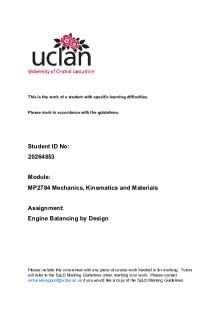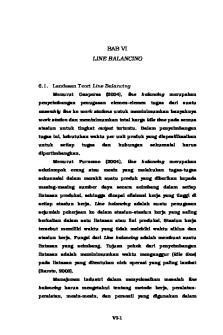Dynamic balancing of a inline engine PDF

| Title | Dynamic balancing of a inline engine |
|---|---|
| Author | Lauren Carbine |
| Course | Mechanics, Kinematics, and Materials |
| Institution | University of Central Lancashire |
| Pages | 14 |
| File Size | 997.9 KB |
| File Type | |
| Total Downloads | 68 |
| Total Views | 154 |
Summary
Dynamically balance a 6 cylinder inline engine with different firing orders, solved graphically...
Description
This is the work of a student with specific learning difficulties.
Please mark in accordance with the guidelines.
Student ID No: 20264853 Module: MP2784 Mechanics, Kinematics and Materials Assignment: Engine Balancing by Design
Please include this coversheet with any piece of course work handed in for marking. Tutors will refer to the SpLD Marking Guidelines when marking your work. Please contact [email protected] if you would like a copy of the SpLD Marking Guidelines.
Contents Introduction...........................................................................................................................................5 Engine Design 1.....................................................................................................................................5 Initial Conditions................................................................................................................................5 Layout Diagram..................................................................................................................................7 Primary Angular Positions Diagram...................................................................................................7 Secondary Angular Positions Diagram...............................................................................................8 Table of values...................................................................................................................................8 Primary (mr) polygons.......................................................................................................................9 Secondary (mr) Polygon.....................................................................................................................9 Primary (mrd) Polygon.....................................................................................................................10 Secondary (mrd) Polygon.................................................................................................................11 Engine Design 2...................................................................................................................................12 Initial Conditions..............................................................................................................................12 Layout Diagram................................................................................................................................12 Primary Angular Positions Diagram.................................................................................................13 Secondary Angular Positions Diagram.............................................................................................13 Table of values.................................................................................................................................14 Primary (mr) polygons.....................................................................................................................14 Secondary (mr) Polygon...................................................................................................................15 Primary (mrd) Polygon.....................................................................................................................15 Secondary (mrd) Polygon.................................................................................................................16 Design Evaluation................................................................................................................................16
Introduction To dynamically balance two alternative engine designs for a two-stroke, six-cylinder diesel engine. Both designs will be evaluated through complete analysis of forces and moments in order to demonstrate the effect of firing order in car engine balancing.
Engine Design 1
Initial Conditions Stroke Length (s) = 0.09 m Length (l) = 0.2 m Crank (r) =
s 2
=
0.09 2
= 0.045 m
Reciprocating Mass (m) = 5.0 Kg Engine Speed (ω) =
2 πRpm 60
=
2 π × 2500 60
= 262 rad/s
Cylinder Spacing = 0.15 m Angular Intervals =
No of Strokes × 180 ° No of Cyliders
=
2 ×180 ° 6
= 60°
Firing Order = 1-5-3-6-2-4 Obligatory Ratio =
l r
=
0.2 0.045
= 4.44 m
Distance (d) = Crank position from the Reference plane
Layout Diagram Figure 1 diagram illustrated the spacing of the cylinders with a defined central reference plane for the moments to be taken about.
Figure 1 Layout Diagram
Primary Angular Positions Diagram Figure 2 showed Primary crank positions at the instant when crank 1 is at top dead centre. Position of the cranks in firing order relative to the assumed clockwise direction of angular velocity.
Figure 2 Primary Crank Positions Diagram
Secondary Angular Positions Diagram Figure 3 diagram plotted for secondary crank positions in which all angles have been doubled, as these forces occur twice per every rotation of the shaft at the instant were crank 1 is at top dead centre.
Figure 3 shows secondary crank position
Table of values Table 1 below provided the initial values to be used to construct (mr) and (mrd) and mrd=m×r × d . polygons. Where mr=m× r Table 1 shows values of mr and mrd
Mass (m)
Radius (r)
Distance (d)
MR
MRD
Kg
m
m
Kg-m
1
5.000
0.045
-0.375
2
5.000
0.045
3
5.000
4
Kg-m²
θ Degree s
Degrees
0.225
-0.084375
0
0
-0.225
0.225
-0.050625
120
240
0.045
-0.075
0.225
-0.016875
240
120
5.000
0.045
0.075
0.225
0.016875
60
120
5
5.000
0.045
0.225
0.225
0.050625
300
240
6
5.000
0.045
0.375
0.225
0.084375
180
0
Crank Position
2θ
Primary (mr) polygons Primary force: mrω² cosθ The primary (mr) polygon in figure 4 was drawn at the instant were crank one is at top dead centre. Scale 3cm = 0.225 m
Figure 4 shows primary (mr) polygon
Secondary (mr) Polygon Secondary force: mrω² cos2θ/n The secondary (mr) polygon in figure 5 was drawn at the instant were crank one is at top dead centre Scale 3cm = 0.225 m
Figure 5 shows secondary (mr) polygon
Figure 4 and 5 demonstrate primary and secondary polygons to be enclosed which signifies the resultant to be 0. Therefore, primary and secondary inertia forces of the reciprocating parts are balanced.
Primary (mrd) Polygon Primary moment: mrxω2 cosθ The maximum out-of-balance couple represented in figure 6 by the dashed line. Scale 1cm = 0.75(mr)
Figure 6 shows primary couples polygon
The maximum out of balance primary couple is obtained by the closing line that is (6.93 ×0.016875)(
2 π ×2500 ) 60
² = 8015 Nm .
This occurs when crank 1 has rotated 210° or 30° from top-dead-centre.
Secondary (mrd) Polygon Secondary Moment: mrxω2 cos2θ/n Scale 1cm = 0.75(mr)
Figure 7 shows secondary (mrd) polygon
The closed polygon show no unbalanced secondary moments.
Engine Design 2 Initial Conditions Stroke Length (s) = 0.09 m Length (l) = 0.2 m Crank (r) =
s 2
=
0.09 2
= 0.045 m
Reciprocating Mass (m) = 5.0 Kg Engine Speed (ω) =
2 πRpm 60
=
2 π × 2500 60
= 262 rad/s
Cylinder Spacing = 0.15 m Angular Intervals =
No of Strokes × 180 ° No of Cyliders
=
2 ×180 ° 6
= 60°
Firing Order = 1-4-5-2-3-6 Obligatory Ratio =
l r
=
0.2 0.045
= 4.44 m
Distance (d) = Crank position from the Reference plane
Layout Diagram Figure 8 diagram illustrated the spacing of the cylinders with a defined central reference plane for the moments to be taken about.
Figure 8 Layout Diagram
Primary Angular Positions Diagram Figure 9 showed Primary crank positions at the instant when crank 1 is at top dead centre. Position of the cranks in firing order relative to the assumed clockwise direction of angular velocity.
Figure 9 primary crank positions diagram
Secondary Angular Positions Diagram Figure 10 diagram plotted for secondary crank positions in which all angles have been doubled, as these forces occur twice per every rotation of the shaft at the instant were crank 1 is at top dead centre.
Figure 10 secondary crank positions diagram
Table of values Table 2 below provided the initial values to be used to construct (mr) and (mrd) polygons. Where mr=m× r and mrd=m×r × d
Mass (Kg)
Radius (m)
Distance (m)
MR
Couples (MRD)
θ
m
Kg-m
Kg-m²
Degrees
2θ Degree s
Kg
m
1
5.000
0.045
-0.375
0.225
-0.084375
0
0
2
5.000
0.045
-0.225
0.225
-0.050625
180
0
3
5.000
0.045
-0.075
0.225
-0.016875
120
240
4
5.000
0.045
0.075
0.225
0.016875
300
240
5
5.000
0.045
0.225
0.225
0.050625
240
120
6
5.000
0.045
0.375
0.225
0.084375
60
120
Crank Position
Table 2 - shows values for mr and mrd
Primary (mr) polygons Primary force: mrω² cosθ The primary (mr) polygon in figure 11 was drawn at the instant were crank one is at top dead centre.
Figure 11 primary force polygon
Secondary (mr) Polygon Secondary force: mrω² cos2θ/n The secondary (mr) polygon in figure 12 was drawn at the instant were crank one is at top dead centre.
Figure 12 secondary force polygon
The primary and secondary force polygons close demonstrating that the primary and secondary forces are in balance.
Primary (mrd) Polygon Primary moment: mrxω2 cosθ Scale 1cm = 0.75(mr)
Figure 13 primary moment polygon
Secondary (mrd) Polygon Secondary Moment: mrxω2 cos2θ/n Scale 1cm = 0.75(mr)
Figure 14 - secondary moment polygon
The maximum out of balance secondary couple is obtained by the closing line that is (
13.8 × 0.016875 2 π ×2500 ) )( 60 4.44
² = 3609 Nm
And this occurs when crank 1 is at position 150 o, 60o, 240o or 330o, since the secondary polygon rotates at 2ω.
Design Evaluation Both engines exhibit primary balanced forces, these forces created by the reciprocating mass of the pistons occur once every rotation of the crankshaft. This demonstrates balance where the central principal axis is not displaced parallel to the rotating centreline whist the piston moves up and down, meaning the engine would not vibrate.
Similarly, both secondary forces are in balance, these forces occur twice per revolution of the crankshaft. These forces created because of the speed variation of the piston as it reaches top dead centre to bottom dead centre causing a difference in inertia, which is not present in this case. It is also clear from the table and radial diagrams that the primary and secondary forces balance at all times since the engine has equal reciprocal masses and equal crank spacing. Crank and connecting-rod dimensions are identical. However, although both engines are statically balanced there is imbalanced couples present in both engines meaning that neither are dynamically balanced. Engine one primary couple imbalance occurs during every rotation of the crankshaft with crank one at 210° and 30°. This imbalance caused by reciprocating masses at 180° separation along different planes shows crank 6 and 1 to cause the imbalance as the weight is disproportional. This would cause vibration along the shaft. Engine two secondary couple imbalance occurs twice per rotation of the crankshaft with crank 1 at 60°, 150° 240° and 330° due to crank 1 and crank 2 speed variation from top dead centre to bottom dead centre at 180° along the shaft. Both conditions of unbalance cause a central principal mass axis to intersect the rotating centreline. In dynamic engine balancing both unbalances can be solved with calibration instructing correct balancing weights....
Similar Free PDFs

Dynamic balancing of a inline engine
- 14 Pages

Static and Dynamic Balancing
- 14 Pages

Static and Dynamic Balancing
- 5 Pages

Manufacuting of Engine Block
- 9 Pages

balancing of rotating masses
- 25 Pages

Balancing of Reciprocating Masses
- 11 Pages

line balancing
- 22 Pages

Line Balancing
- 21 Pages

A proof-producing boolean search engine
- 117 Pages

Transmit Engine
- 4 Pages

Heat Engine
- 8 Pages
Popular Institutions
- Tinajero National High School - Annex
- Politeknik Caltex Riau
- Yokohama City University
- SGT University
- University of Al-Qadisiyah
- Divine Word College of Vigan
- Techniek College Rotterdam
- Universidade de Santiago
- Universiti Teknologi MARA Cawangan Johor Kampus Pasir Gudang
- Poltekkes Kemenkes Yogyakarta
- Baguio City National High School
- Colegio san marcos
- preparatoria uno
- Centro de Bachillerato Tecnológico Industrial y de Servicios No. 107
- Dalian Maritime University
- Quang Trung Secondary School
- Colegio Tecnológico en Informática
- Corporación Regional de Educación Superior
- Grupo CEDVA
- Dar Al Uloom University
- Centro de Estudios Preuniversitarios de la Universidad Nacional de Ingeniería
- 上智大学
- Aakash International School, Nuna Majara
- San Felipe Neri Catholic School
- Kang Chiao International School - New Taipei City
- Misamis Occidental National High School
- Institución Educativa Escuela Normal Juan Ladrilleros
- Kolehiyo ng Pantukan
- Batanes State College
- Instituto Continental
- Sekolah Menengah Kejuruan Kesehatan Kaltara (Tarakan)
- Colegio de La Inmaculada Concepcion - Cebu




